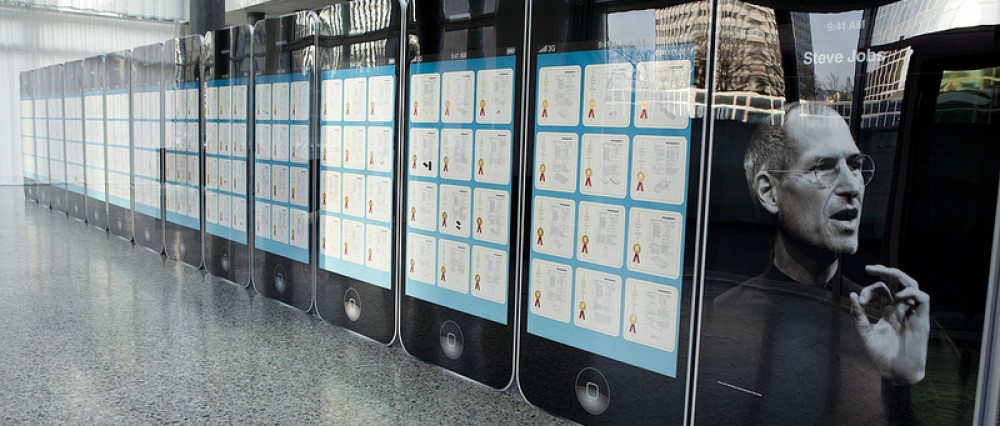Stephen E. Weil, senior emeritus scholar at the Center for Museum Studies at the Smithsonian Institution in Washington D.C., says that museums should “concentrate on providing a variety of primarily educational services to the public, and [the museum] will measure its success in that effort by the overarching criterion of whether it is actually able to provide those services in a demonstrably effective way” (Weil, 1999)–meaning that instead of being about something, the library or museum should be for someone, most notably the community it represents. At the SJLM we are not about Steve Jobs, the man; we are for tech-loving visionaries and all those fans who admire the Zen beauty of innovative, user-friendly design.
SJLM strives to model Steve Job’s passion for innovation emulating his mantra, “You can’t just ask customers what they want and then try to give that to them. By the time you get it built, they’ll want something new.” (Steve Jobs) At SJLM, we will not be lead, but we will lead. We are instruments of social change through education and community outreach. In the same way that Apple’s iPhone and iPad connect people to each other and the World Wide Web, our programs connect our visitors with a broader experience; our goal is to foster “social interactions around the museums artifacts and ultimately the process of shared construction of meaning making,” (Charitonos, 2012) thus, ensuring that “audiences understand the [museums’] pertinence and value to our lives.” (Proctor, 2010) Our strategic use of social media including Facebook, Twitter, Pinterest and YouTube, will allow us to collect feedback data and measure our effectiveness in educating and engaging our patrons.
Social Media: A Multi-way Communication Strategy
According to Fletcher and Lee, most museums use social media for one-way communication that focus on “event listing, reminders, and reaching larger or newer audiences by increasing the number of fans and promotional messaging”. Our goal is to use social media in a more participatory “multi-way communication strategy.” (Fletcher & Lee, 2012) Aside from marketing and promotion, SJLM plans to “partner with other organizations, publish in non-traditional formats, and encourage audience participation by brokering online cultural exchanges through social media platforms.” (Russo, 2011) In the same way that the British Museum, the BBC and author Neil MacGregor partnered to produce the A History of the World in 100 Objects project, (Russo, 2011) SJLM plans to partner with Apple Inc. and Jobs biographer Walter Isaacson to produce a series of podcasts available for free on iTunes entitled “iApple: What’s at the Core” featuring the ten most iconic objects from Steve Jobs’ career. Listeners will be invited use the SJLM’s Twitter and Facebook pages to describe how they were impacted by those objects. An eleventh podcast will then be produced based on the responses. Our goal is to be as successful as the 100 Objects project which received the Art Fund Prize for the “truly global scope of the British Museum’s project, which combined intellectual rigour and open heartedness, and went far beyond the boundaries of the museum’s walls. Above all, we felt that this project, which showed a truly pioneering use of digital media, has led the way for museums to interact with their audiences in new and different ways. Without changing the core of the British Museum’s purpose, people have and are continuing to engage with objects in an innovative way as a consequence of this project.”(British Museum, 2011) Having our listeners and visitors participate in on-going discussions and engage with our exhibits in new and innovative ways through social media is one of our prime directives for partnering with like-minded organizations.
Building a Portfolio of Experiences
Social media affords the opportunity to engage more fully with patrons before, during and after their visit to the SJLM. Our Twitter feed concentrates on “linking resources, creatively engaging the public…and creating an active two way form of communication” (Osterman et al, 2012) that encourages visitor feedback and word-of-mouth promotion of our library and museum. By using Facebook to share and connect with its stakeholders and visitors, SJLM can position itself as a “vibrant and relevant organization in our national cultural imagery.” (Russo, 2011) The visual interface of Pinterest affords the opportunity to highlight our collection, promote our gift shop and to display the interests of our wider community. (Fuchs, 2012) All three platforms allow us to generate discussion, collaborate, recommend and share resources developing loyal supporters and visitors. By extending the visitor experience through social media interaction, “visitors will build a portfolio of experiences that can be used to strengthen learning and promote repeat visitation.” (Bird, 2012)
Using Video to Personalize the Museum Experience
The SJLM strategically uses video across the entire life cycle of the patrons’ experience with the library. Our YouTube channel affords us the means to illicit, engage, educate and serve our visitors. (Grensing-Pophal, 2012) Similar to the Children’s Museum of Indianapolis’s WOW web series, our web series focuses on the exciting aspects of the library and museum and is “promoted in multiple locations on the museum’s website, sent out to its email database and posted to social platforms including Facebook, Twitter and YouTube.” (Grensing-Pophal, 2012) Our series features two “Geniuses,” recognizable on-staff actors who create content, host programs and interact with visitors; this connects the virtual online experience with the actual brick-and-mortar library and museum. Using iPhone and iPad stations, visitors can record themselves at the museum and send the video to a secure account that can be accessed from home or the Exploratorium. In the Exploratorium, visitors of all ages can access their videos and edit the content by adding effects using iMovie. The video can also be used in one of our many digital media workshops; the final products can be submitted at any time to our monthly iPhone Film Competition and are posted to our YouTube Channel. The resulting “personalization of the experience provides motivation to access and continue the experience of the exhibition” (Bird, 2012) long after the visitors have left our building.
